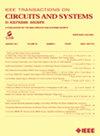SLICENet: An FPGA-Based Efficient Semantic Segmentation Network for Edge Deployment
IF 4.9
2区 工程技术
Q2 ENGINEERING, ELECTRICAL & ELECTRONIC
IEEE Transactions on Circuits and Systems II: Express Briefs
Pub Date : 2025-07-25
DOI:10.1109/TCSII.2025.3592480
引用次数: 0
Abstract
Semantic segmentation is a pixel-level visual recognition task widely used in autonomous driving. Attaining a decent trade-off between accuracy and speed is critically important for the effective physical deployment of networks on resource-constrained edge devices. Towards this challenging task, we propose an efficient basic block that is designed to leverage local, short-range, and long-range contextual information at different abstraction levels. We introduce a simple technique inside the basic block, called Iterative Context Embedding (ICE), to reinforce the short and long-range contextual details in an iterative fashion. Based on the resulting short and long-range ICE or SLICE module, we propose an ultra-lightweight network, called SLICENet. Our model is the fastest among the existing ultra-lightweight models while achieving a decent accuracy. Specifically, with only 0.3 million parameters, it achieves 69.1% mean IoUs on the cityscapes test set, making it the smallest model to achieve this accuracy. In addition, it achieves an inference speed of 224.8 frames per second (FPS) on the RTX 3090 withSLICENet:基于fpga的边缘部署高效语义分割网络
语义分割是一种广泛应用于自动驾驶领域的像素级视觉识别任务。在准确性和速度之间取得良好的平衡对于在资源受限的边缘设备上有效地部署网络至关重要。针对这一具有挑战性的任务,我们提出了一个有效的基本块,旨在利用不同抽象级别的本地、短程和远程上下文信息。我们在基本块中引入了一种简单的技术,称为迭代上下文嵌入(ICE),以迭代的方式加强短期和长期的上下文细节。基于由此产生的短距离和远距离ICE或SLICE模块,我们提出了一种超轻量级网络,称为SLICENet。我们的模型是现有的超轻量模型中最快的,同时达到了不错的精度。具体来说,在只有30万个参数的情况下,它在城市景观测试集上达到了69.1%的平均欠条,是达到这一精度的最小模型。此外,它在RTX 3090上实现了每秒224.8帧(FPS)的推理速度,分辨率为512 × 1024。为了实现电池供电设备的节能解决方案,我们还将我们的模型部署在赛灵思的ZCU102开发板(Zync UltraScale+ MPSoC)上。尽管取得了令人印象深刻的性能,但其功耗仅为950兆瓦;明显低于基于gpu的推断。我们的代码将在https://github.com/NadeemAtif-Alig/SLICENet上共享。
本文章由计算机程序翻译,如有差异,请以英文原文为准。
求助全文
约1分钟内获得全文
求助全文
来源期刊
CiteScore
7.90
自引率
20.50%
发文量
883
审稿时长
3.0 months
期刊介绍:
TCAS II publishes brief papers in the field specified by the theory, analysis, design, and practical implementations of circuits, and the application of circuit techniques to systems and to signal processing. Included is the whole spectrum from basic scientific theory to industrial applications. The field of interest covered includes:
Circuits: Analog, Digital and Mixed Signal Circuits and Systems
Nonlinear Circuits and Systems, Integrated Sensors, MEMS and Systems on Chip, Nanoscale Circuits and Systems, Optoelectronic
Circuits and Systems, Power Electronics and Systems
Software for Analog-and-Logic Circuits and Systems
Control aspects of Circuits and Systems.

 求助内容:
求助内容: 应助结果提醒方式:
应助结果提醒方式:


